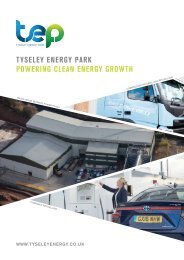connected-clusters-report-energy
Clustering innovation to create thriving and prosperous low-carbon cities and regions
Clustering innovation to create thriving and prosperous low-carbon cities and regions
Create successful ePaper yourself
Turn your PDF publications into a flip-book with our unique Google optimized e-Paper software.
ConnectedClusters Landscaping Study 54<br />
Conclusions<br />
Climate-KIC believes that the climate change challenge cannot be met in a<br />
‘business as usual’ fashion. That is why the development of effective low-carbon<br />
<strong>clusters</strong> is so important. To date, some of the activity ascribed to <strong>clusters</strong> has been<br />
rather narrowly conceived and has had limited impact. There is a value in bringing<br />
together a number of companies in the same sector for a trade visit and maintaining<br />
e-mail contact with them afterwards. However, at best, this is cluster 1.0.<br />
We are exploring an approach that is much more ambitious and comprehensive.<br />
From the activities outlined above, we are able<br />
to suggest the elements of a comprehensive<br />
climate innovation cluster scale which indicates<br />
a number of key features of thriving climate<br />
innovation <strong>clusters</strong>:<br />
o Broad partnerships<br />
o Aim to influence policy<br />
o Stimulate new companies<br />
o Diverse means of funding<br />
o Promote collaboration<br />
alongside competition<br />
o Foster skills development<br />
o Have a public profile and identity<br />
Clusters can assess their progress and<br />
impact against this scale. This vision would<br />
be the development of Cluster 4.0, where the<br />
learning from the cluster experience is shared<br />
and fed back to the ecosystem of low-carbon<br />
innovation <strong>clusters</strong>.<br />
The creation of these city region ecosystems<br />
in a market sector that will grow exponentially<br />
in years to come is crucial to Europe’s aim<br />
to boost innovation and export solutions to<br />
the world. And they are key to delivering on<br />
national and city region aims – not just on<br />
sustainability and climate, but across a range<br />
of outcomes from reduced air pollution to<br />
better health and wellbeing, more employment<br />
and buzzing places. But to do this at the<br />
speed and scale required, <strong>clusters</strong> must link<br />
to and learn from each other. This is where the<br />
ConnectedClusters project comes in.<br />
Evidence shows that the fastest innovation<br />
can be achieved in <strong>clusters</strong> – Silicon Valley<br />
being the most celebrated example –<br />
but broader, city region-wide climate innovation<br />
<strong>clusters</strong> have received relatively little attention<br />
until now. This clustering of climate innovation<br />
gives city regions huge potential to drive<br />
systemic shifts in how we live – this is what<br />
ConnectedClusters will explore and accelerate.<br />
Climate-KIC believes this could be the answer<br />
to delivering climate action rapidly and<br />
hand-in-hand with strong economic and<br />
social progress.<br />
This <strong>report</strong> showcases five concrete<br />
examples in which climate innovation is<br />
clustered around cities (bringing quadruple<br />
helix stakeholders) and the impact of these<br />
climate innovation <strong>clusters</strong> on growth of the<br />
regions and cities in which these <strong>clusters</strong><br />
are embedded. This manifests itself in many<br />
forms – from new innovations being brought to<br />
market to the creation of skilled, clean jobs and<br />
the greening of industry. The success of these<br />
<strong>clusters</strong> provides a template for scaling the<br />
climate innovation <strong>clusters</strong> up across the entire<br />
European continent with the aim of multiplying<br />
climate impact.<br />
Creating thriving low-carbon city regions is the<br />
most efficient and effective way to generate<br />
innovation and economic growth at scale at<br />
the same time as co-benefits, from reduced<br />
air pollution and fuel poverty to improved<br />
health and sustainable skills and employment<br />
for local people.<br />
Climate innovation <strong>clusters</strong> differ from<br />
traditional <strong>clusters</strong> in that they are broader<br />
than support aimed at SMEs and entrepreneurs.<br />
They recognise the important role of public<br />
and private sector innovation and practice in<br />
cutting carbon and boosting climate resilience,<br />
rather than purely early stage business growth.<br />
They bring together businesses of all sizes,<br />
researchers, governments and communities<br />
across city regions to make rapid progress in<br />
systemically transforming the way we live for a<br />
thriving, zero-carbon future.<br />
Creating thriving low-carbon city regions is our<br />
best chance of creating impact on the scale<br />
required to achieve the Paris targets while also<br />
supporting local economic growth and creating<br />
vibrant, healthy places.




